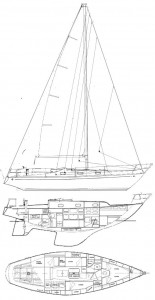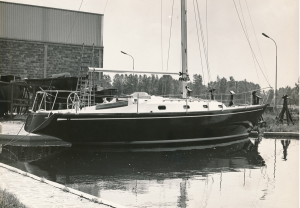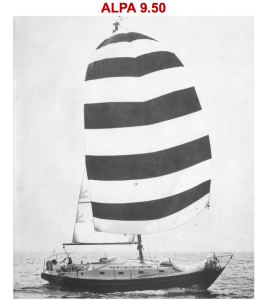Alpa 9.50 “What I like most about the 9.50 is that she is seaworthy and fast and she sails herself which just does not happen with modern boats”
Nardi’s Nods – By Federico Nardi of Cantiere Navale Dell Argentario. Translated by James Robinson Taylor
This excellent modern classic design comes from the Alpa Yard of Danilo Cattadori, established in Fiesco, Cremona in Northern Italy, in 1956. Altogether the yard built some 22,000 boats – one every three days in the heyday of the 1960s and 1970s.
The yard was one of the early adopters of glassfibre yachts and there was a test tank for some development – in 1963 they built the largest glassfibre boat in Europe (at 49ft/15m).
The Alpas ranged from the 13ft 3in (4m) Flying Juniors to the Flying Dutchman and the 48ft 3in (14.7m) Anselmi e Boretti Yawl, the Alpa A15. Cattadori mainly worked with Van de Stadt, S&S and Illingworth designs but in 1970 developed the 9.50, a 31ft 2in (9.5m) auxiliary masthead sloop with a lovely semi long-keel underwater profile and 1,650 Kg of lead ballast.
The five-berth Alpa 9.50 was extremely well built and found many fans – almost all are certainly still afloat.
What I like most about the 9.50 is that she is seaworthy and fast and she sails herself which is something that just does not happen any more with modern boats. You can get her balanced and go below to make a cup of coffee while she tracks along.
She also sails really well in rough seas, and is still well balanced when you reduce her canvas; she moves softly through the waves and the helm is light, it’s a semi-balanced configuration with the rudder on the skeg – with many modern boats you just feel like you are in a survival mode as soon as it starts blowing.
I don’t really like the wheel and I would rather have a tiller but perhaps that takes up space in the cockpit; in any case you don’t need a helm because she can sail herself!
The anodised aluminium deck hardware – fairleads, cleats and so on are like sculptures and they will be long-lasting.
The aluminium mast is solidly built with just one spreader. It’s deck-stepped, but I don’t like that too much either – there is no technical reason of course, just that I would feel safer seeing the mast coming down to the keel. All that loading across the cabin top psychologically bothers me!
However the internal layout is super classic, well proportioned and comfy as well as being an enjoyable space; the internal linings have lasted really well on many models.
The Alpa boats all had a reputation for being made for seaworthiness and for keeping their owners and crew happy in a seaway. The deck was attached to the hull with a rounded joint that created a strong and long-lasting seal. And as far as we know no Alpa’s chainplates ever failed – the chainplates were designed to hold the entire weight of the boat. They have no problems with osmosis and many are still afloat.
The Alpa yard made its last yacht in 1978 and closed in 1979. Nowadays there is an Italian firm called Alpa making motor boats.
In the 1980s and 90s it is true that technology got better in terms of boat construction but really this decreased the cost of products and parts and reduced labour costs. It did not result in better build quality.
So it still makes sense to go for one of these older designs.You can pick these marvelous cruiser racers up for around €12,000 – sometimes even less and they would take you anywhere. A true modern classic! ★
The Alpa Nine-Fifty
LOA 31ft 2in (9.5m)
Beam 9ft .71in (2.96m)
Draught 6ft 1in (1.86m)
Sail Area 389 sq ft (36.14m2)
Displacement 9800lbs 4445kgs






